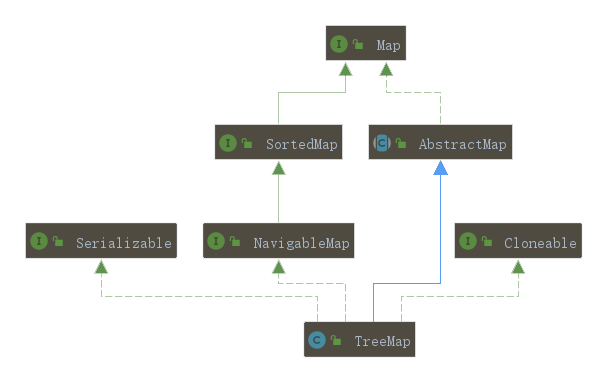类前注释
基于红黑树的NavigableMap实现。Map的key根据自然排序或在创建时提供的Comparator对key进行排序。
TreeMap为containsKey,get,code put和remove操作保证了log(n)时间成本。算法是对Cormen,eiserson和Rivest的算法简介中的算法的改编。
注意,此实现不是同步的。 如果多个线程同时访问一个地图,并且至少所述修改的线程中的一个的映射结构,它必须保持外部同步。(结构上的修改是指添加或删除一个或多个映射的操作;仅改变与现有键关联的值是不是结构修改)。这通常是通过一些对象上同步自然封装该地图来实现的。 如果该对象不存在时,地图应当"包装"使用Collections.synchronizedSortedMap方法。 这最好在创建时完成,以防止对映射进行意外的不同步访问:
SortedMap m = Collections.synchronizedSortedMap(new TreeMap(...)); 在返回的迭代器iterator的所有此类的"collection方法"返回集合的方法是快速失败的:如果集合随时修改创建迭代器之后,以任何方式除非通过迭代器自身的remove方法,迭代器将抛出ConcurrentModificationException。 因此,在并发的修改时,迭代器很快就会失败,而不是在将来不确定的时间发生不确定性的行为。
注请注意,不能保证迭代器的快速失败行为。通常来说,在存在不同步的并发修改的情况下,不可能做出任何严格的保证。 快速迭代器会尽最大努力抛出ConcurrentModificationException,因此,编写依赖于此异常的程序的正确性是错误的:迭代器的快速故障行为仅应用于检测错误。
- 节点分为红色或者黑色;
- 根节点必为黑色;
- 叶子节点都为黑色,且为null;
- 连接红色节点的两个子节点都为黑色(红黑树不会出现相邻的红色节点);
- 从任意节点出发,到其每个叶子节点的路径中包含相同数量的黑色节点;
- 新加入到红黑树的节点为红色节点;
- 变色:在不违反上述红黑树规则特点情况下,将红黑树某个node节点颜色由红变黑,或者由黑变红;
- 左旋:逆时针旋转两个节点,让一个节点被其右子节点取代,而该节点成为右子节点的左子节点
- 右旋:顺时针旋转两个节点,让一个节点被其左子节点取代,而该节点成为左子节点的右子节点
类图

成员变量
/**
* 我们前面提到TreeMap是可以自动排序的,默认情况下comparator为null,这个时候按照key的自然顺序进行排
* 序,然而并不是所有情况下都可以直接使用key的自然顺序,有时候我们想让Map的自动排序按照我们自己的规则,
* 这个时候你就需要传递Comparator的实现类
*/
private final Comparator<? super K> comparator;
/**
* TreeMap的存储结构既然是红黑树,那么必然会有唯一的根节点。
*/
private transient Entry<K,V> root;
/**
* Map中key-val对的数量,也即是红黑树中节点Entry的数量
*/
private transient int size = 0;
/**
* 红黑树结构的调整次数
*/
private transient int modCount = 0;
private static final boolean RED = false;
private static final boolean BLACK = true;TreeMap中的每个节点定义如下所示:
static final class Entry<K,V> implements Map.Entry<K,V> {
//key,val是存储的原始数据
K key;
V value;
//定义了节点的左孩子
Entry<K,V> left;
//定义了节点的右孩子
Entry<K,V> right;
//通过该节点可以反过来往上找到自己的父亲
Entry<K,V> parent;
//默认情况下为黑色节点,可调整
boolean color = BLACK;
/**
* 构造器
*/
Entry(K key, V value, Entry<K,V> parent) {
this.key = key;
this.value = value;
this.parent = parent;
}
/**
* 获取节点的key值
*/
public K getKey() {return key;}
/**
* 获取节点的value值
*/
public V getValue() {return value;}
/**
* 用新值替换当前值,并返回当前值
*/
public V setValue(V value) {
V oldValue = this.value;
this.value = value;
return oldValue;
}
public boolean equals(Object o) {
if (!(o instanceof Map.Entry))
return false;
Map.Entry<?,?> e = (Map.Entry<?,?>)o;
return valEquals(key,e.getKey()) && valEquals(value,e.getValue());
}
public int hashCode() {
int keyHash = (key==null ? 0 : key.hashCode());
int valueHash = (value==null ? 0 : value.hashCode());
return keyHash ^ valueHash;
}
public String toString() {
return key + "=" + value;
}
}构造方法
/**
* 构造一个新的,空的TreeMap,使用键的自然顺序。
* 插入到TreeMap中的所有Key都必须实现Comparable接口。
* 另外,所有这些Key必须是可比较的:任何在地图上的键k1和k2,k1.compareTo(k2)不得抛出ClassCastException。
*/
public TreeMap() {
comparator = null;
}
/**
* 构造一个新的,空的TreeMap,传递自定义比较器。
*/
public TreeMap(Comparator<? super K> comparator) {
this.comparator = comparator;
}
public TreeMap(Map<? extends K, ? extends V> m) {
comparator = null;
putAll(m);
}
public TreeMap(SortedMap<K, ? extends V> m) {
comparator = m.comparator();
try {
buildFromSorted(m.size(), m.entrySet().iterator(), null, null);
} catch (java.io.IOException cannotHappen) {
} catch (ClassNotFoundException cannotHappen) {
}
}put
public V put(K key, V value) {
Entry<K,V> t = root;
if (t == null) {
compare(key, key); // type (and possibly null) check
//第一次put元素,root为空,创建根节点
root = new Entry<>(key, value, null);
size = 1;
modCount++;
return null;
}
/**
* 如果节点不为null,定义一个cmp,这个变量用来进行查找时的比较;
*/
int cmp;
//定义parent,是new Entry时必须要的参数
Entry<K,V> parent;
//cpr表示有无自己定义的排序规则,分两种情况遍历执行
Comparator<? super K> cpr = comparator;
if (cpr != null) {
do {
/**
* 从root节点开始遍历,通过逐步向下找
* 第一次循环:从根节点开始,这个时候parent就是根节点,然后通过自定义的排序算法
* cpr.compare(key, t.key)比较传入的key和根节点的key值,如果传入的key<root.key,那么
* 继续在root的左子树中找,从root的左孩子节点(root.left)开始:如果传入的key>root.key,
* 那么继续在root的右子树中找,从root的右孩子节点(root.right)开始;如果恰好key==root.key,
* 那么直接更新root节点的value值即可。
* 后面的循环规则一样,当遍历到的当前节点作为起始节点,逐步往下找
*
* 需要注意的是:这里并没有对key是否为null进行判断,建议自己的实现Comparator时应该要考虑在内
*/
parent = t;
cmp = cpr.compare(key, t.key);
if (cmp < 0)
t = t.left;
else if (cmp > 0)
t = t.right;
else
return t.setValue(value);
} while (t != null);
}
else {
//默认排序时TreeMap不支持key为NULL
if (key == null)
throw new NullPointerException();
@SuppressWarnings("unchecked")
Comparable<? super K> k = (Comparable<? super K>) key;
do {
parent = t;
cmp = k.compareTo(t.key);
if (cmp < 0)
t = t.left;
else if (cmp > 0)
t = t.right;
else
return t.setValue(value);
} while (t != null);
}
/**
* 执行到这里,说明前面并没有找到相同的key,节点已经遍历到最后了,我们只需要new一个Entry放到
* parent下面即可,但放到左子节点上还是右子节点上,就需要按照cmp来。
*/
Entry<K,V> e = new Entry<>(key, value, parent);
if (cmp < 0)
parent.left = e;
else
parent.right = e;
/**
* 一般情况下加入节点都会对红黑树的结构造成
* 破坏,需要通过一些操作来进行自动平衡处置,如【变色】【左旋】【右旋】
*/
fixAfterInsertion(e);
size++;
modCount++;
return null;
}get
public V get(Object key) {
Entry<K,V> p = getEntry(key);
return (p==null ? null : p.value);
}
/**
* 从root节点开始遍历,通逐步向下找
* 第一次循环:从根节点开始,这个时候parent就是根节点,然后通过k.compareTo(p.key)比较传入的key和
* 根节点的key值;
* 如果传入的key<root.key, 那么继续在root的左子树中找,从root的左孩子节点(root.left)开始;
* 如果传入的key>root.key, 那么继续在root的右子树中找,从root的右孩子节点(root.right)开始;
* 如果恰好key==root.key,那么直接返回root节点即可。
* 后面的循环规则一样,当遍历到的当前节点作为起始节点,逐步往下找
*/
final Entry<K,V> getEntry(Object key) {
// Offload comparator-based version for sake of performance
if (comparator != null)
return getEntryUsingComparator(key);//存在比较器,使用此方法,思路一样的
//默认排序情况下的查找
if (key == null)
throw new NullPointerException();
@SuppressWarnings("unchecked")
Comparable<? super K> k = (Comparable<? super K>) key;
Entry<K,V> p = root;
while (p != null) {
int cmp = k.compareTo(p.key);
if (cmp < 0)
p = p.left;
else if (cmp > 0)
p = p.right;
else
return p;
}
return null;
}remove
public V remove(Object key) {
//找到待删除节点
Entry<K,V> p = getEntry(key);
//不存在对应节点直接返回null
if (p == null)
return null;
//保存旧值供后续返回
V oldValue = p.value;
//删除节点
deleteEntry(p);
return oldValue;
}
private void deleteEntry(Entry<K,V> p) {
modCount++;
size--;
// 当左右子节点都不为null时,通过successor(p)遍历红黑树找到前驱或者后继
if (p.left != null && p.right != null) {
Entry<K,V> s = successor(p);
//将前驱或者后继的key和value复制到当前节点p中,然后删除节点s(通过将节点p引用指向s)
p.key = s.key;
p.value = s.value;
p = s;
} // p has 2 children
// Start fixup at replacement node, if it exists.
Entry<K,V> replacement = (p.left != null ? p.left : p.right);
/**
* 至少有一个子节点不为null,直接用这个有值的节点替换掉当前节点,给replacement的parent属性赋值,给
* parent节点的left属性和right属性赋值,同时要记住叶子节点必须为null,然后用fixAfterDeletion方法
* 进行自平衡处理
*/
if (replacement != null) {
//将待删除节点的子节点挂到待删除节点的父节点上。
replacement.parent = p.parent;
if (p.parent == null)
root = replacement;
else if (p == p.parent.left)
p.parent.left = replacement;
else
p.parent.right = replacement;
// Null out links so they are OK to use by fixAfterDeletion.
p.left = p.right = p.parent = null;
/**
* p如果是红色节点的话,那么其子节点replacement必然为红色的,并不影响红黑树的结构
* 但如果p为黑色节点的话,那么其父节点以及子节点都可能是红色的,那么很明显可能会存在红色相连的情
* 况,因此需要进行自平衡的调整
*/
if (p.color == BLACK)
fixAfterDeletion(replacement);
} else if (p.parent == null) { // return if we are the only node.
root = null;
} else {
/**
* 如果p节点为黑色,那么p节点删除后,就可能违背每个节点到其叶子节点路径上黑色节点数量一致的规则,
* 因此需要进行自平衡的调整
*/
if (p.color == BLACK)
fixAfterDeletion(p);
if (p.parent != null) {
if (p == p.parent.left)
p.parent.left = null;
else if (p == p.parent.right)
p.parent.right = null;
p.parent = null;
}
}
}遍历
TreeMap的遍历可以使用map.values(), map.keySet(),map.entrySet(),map.forEach().
public static void main(String[] args) {
TreeMap<Integer,Integer> map = new TreeMap<>();
map.put(1,1);
map.put(3,3);
map.put(2,2);
map.put(5,5);
map.put(4,4);
Collection<Integer> values = map.values();
values.forEach((m)-> System.out.print(m+" "));
System.out.println();
Set<Integer> keys = map.keySet();
keys.forEach((k)-> System.out.print("key="+k+", v="+map.get(k)));
Set<Map.Entry<Integer, Integer>> entries = map.entrySet();
System.out.println();
for (Map.Entry<Integer, Integer> entry : entries) {
System.out.println(entry.getKey()+" "+entry.getValue());
}
System.out.println();
map.forEach((k,v)-> System.out.print("key="+k+", v="+map.get(k)));
} 如果我们想逆序遍历则可以调用descendingMap方法.
map.descendingMap().forEach((k,v)-> System.out.println(k+" "+v));//逆序打印
System.out.println(map.lastEntry().getKey());//获取最大值(即最后一个entry)版权属于:带翅膀的猫
本文链接:https://www.chengpengper.cn/archives/116/
转载时须注明出处及本声明

